Chemistry is playing a vital role in helping remove radioactive material from the environment after the 2011 disaster. Clare Sansom reports
In the whole history of nuclear energy there have only been only two incidents classified as Level Seven: Major Accident on the International Nuclear Event Scale. The scale, from levels one to seven, mirrors that used for earthquakes, in that each level is approximately ten times as severe as the level below. Most informed readers will not need to be told that these are the disasters at Chernobyl in what is now Ukraine in 1986 and at Fukushima in Japan in 2011.
The events at Fukushima were triggered by a magnitude 9 earthquake – the fifth most powerful since modern records began in 1900 – that occurred off the Japanese coast on 11 March. Three years on, over 15,000 deaths have been directly attributed to the earthquake and the subsequent tsunami, and over 2,000 people are still listed as missing. This would have been bad enough on its own, but the tsunami caused the meltdown of three of the six boiling water reactors at the Fukushima Daiichi nuclear power plant, located at Okuma on the coast of Fukushima province, not far from the underwater epicentre of the earthquake.
The radioactivity release from the Fukushima reactors was first observed the day after the tsunami hit; the total has been estimated as anything up to 8 × 1017 Bq (one Becquerel is defined as the unit of radiation in which one nuclear decay occurs in a second). ‘Taking both the fallout from the atmosphere and the release of radioactive water into account, more than 90% of the total radiation ended up in the Pacific Ocean,’ says oceanographer Ken Buesseler of Woods Hole Oceanographic Institution in the US. This total is about a sixth of that released at Chernobyl. It could have been much worse, however: most of the concrete primary containment vessels remained intact, preventing the escape of even more toxic materials, and no deaths in Japan have been directly attributed to the radiation.
Arguably, however, the short-term crisis of a nuclear incident will always be dwarfed by the long-term problems arising from a significant release of radiation into the environment. Radioactive materials continue to be toxic as long as they continue to emit significant quantities of radiation. Most of the radioactivity released at Fukushima was iodine-131 with a short half-life of eight days, and caesium-134 and caesium-137, with half-lives of two and 30 years respectively; xenon-133 was among the radionuclides released in smaller quantities.
Both caesium isotopes decay by beta emission to form the respective isotopes of barium; metastable 137mBa, the immediate product of 137Cs decay, itself decays quickly by gamma emission to give stable 137Ba. Exposure to all these radionuclides is known to lead to an increased probability of developing cancer, with 131I particularly associated with thyroid tumours, but only 137Cs is problematic in the long term because of its long half-life. Almost 30 years after the Chernobyl disaster, for example, the most important radionuclides contaminating the exclusion zone around the stricken plant are 137Cs and 90Sr.
Once released, 137Cs will remain in an environment for generations. Although some radiation occurs naturally and low levels can be considered harmless, decontamination to those levels is a very difficult problem. It is not possible to ‘remove’ radioactivity, so remediation has to be a matter of concentrating and containing it. The International Atomic Energy Agency (IAEA) recommends storage facilities that are appropriate for the first three years after decontamination and for the following 30.
In the soil
One of the most serious problems is contamination of the agricultural land in the area around Fukushima, and particularly its soil. This is expected to affect crop and livestock production and thus the quality of life for Japanese citizens for decades, if to a decreasing extent. The main techniques that have been used to reduce this problem have been scientifically extremely simple: they involve the application of potassium fertiliser, cleaning or pruning of fruit trees, deep ploughing and the removal of topsoil. Simply removing contaminated material such as topsoil, however, creates a large amount of waste that cannot be made safe and will still need to be disposed of.
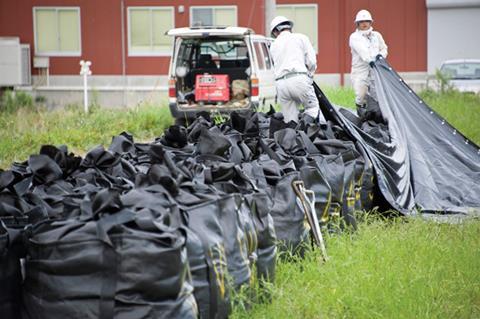
The problem of waste disposal becomes more tractable if the radioactivity can be concentrated into a smaller volume of material. Yoshiharu Mitoma from the Prefectural University of Hiroshima, Japan, and his co-workers have developed an innovative set of techniques for immobilising and separating caesium in soil samples that is being applied to large volumes.
Immobilising radionuclides involves trapping them within a solid matrix of (for example) polymer or ceramic so that it can no longer be leached out of the soil. Any isotope of caesium, whether radioactive or stable, will preferentially adhere to the surfaces of soil and other organic particles. A simple strategy for decontaminating soils could therefore just involve removing the smallest particles with the highest surface to volume ratios, and therefore the highest caesium concentration. ‘We must avoid conventional methods of separating particles by size which use wet samples and will therefore produce radioactive waste water,’ says Mitoma.
The new techniques involve stirring the radioactive soil samples in a ball milling machine with a substance called ‘nano-calcium’. This is a mixture of nanoscale particles of metallic calcium and calcium oxide, sometimes with the addition of metallic iron. Grinding a mixture of soil and nano-calcium both reduces the size of the soil particles and coats each one with nano-calcium, immobilising the caesium in a layer below the particles. This produces a dry sample that can be separated by particle size at room temperature.
If the nano-calcium used contains iron or another paramagnetic material, this separation can be achieved through a balance of magnetic forces and gravity. The coated particles are placed in water underneath a strong magnet, and the smallest particles – those with the highest concentrations of caesium – are attracted to the magnet even against gravity. ‘Our method concentrates radionuclides into a smaller volume of insoluble material that is relatively easy to store,’ says Mitoma. ‘It can be applied to many materials, including ash.’
Fungi fear
Much of the area around Fukushima was cultivated land, and much attention has been focused on the accumulation of radiation in foodstuffs and associated health risks. Some species of plants and many fungi are known to be ‘hyper-accumulators’ of certain metals including caesium. Radionuclide concentrations may therefore be unacceptably high in plants and fungi grown even in mildly affected areas. Some species of edible mushrooms are very efficient hyper-accumulators; the study of radionuclide accumulation in fungi dates back to the 1960s, but became more urgent after the Chernobyl disaster, particularly since wild mushrooms are appreciated as a delicacy in much of eastern Europe.
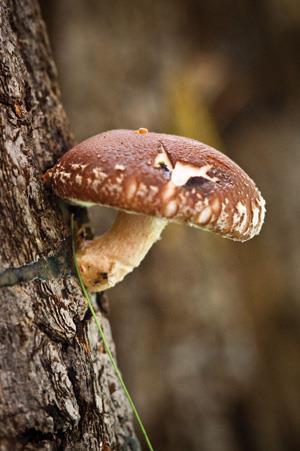
Different fungal species accumulate different metals at different rates; in particular, saprotrophs, which obtain their nutrients from dead or decaying matter in the topsoil, accumulate more quickly and take less time to reach peak concentrations than the mycorrhizal fungi that are associated with the roots of plants. Contamination of edible saprotrophs is no longer considered a problem in Europe, but it has become one in Japan.
Olivier Daillant of the Observatoire Mycologique in Mazille, France, has studied radiation in fungi since the 1980s, and he has explored the extent to which usual cooking methods will remove the accumulated caesium. ‘Normal boiling breaks down the cell walls of the mushrooms, releasing the stored caesium into the liquid’, he explains.
‘More prolonged boiling can often reduce the radioactivity to within the approved “safe” limits, but there will still be some left, and the mushrooms themselves will be less palatable.’ Local mushrooms, therefore, are now regarded as ‘off limits’ by many Japanese residents, at some cost to the economy and to their quality of life. ‘This is not a big problem but [because of the long half-life of 137Cs] it will remain a small one for many years,’ says Daillant.
A drop in the ocean
The release of much of the radiation from Fukushima into the ocean has posed a different set of problems. Again, except in the immediate aftermath of the disaster, 137Cs has been the main cause for concern. Caesium – an alkali metal, like sodium – dissolves in sea water and is carried across the ocean by its currents. It is taken up by, and accumulates in, many species of edible fish. But radiation was present in the ocean before the Fukushima disaster, just as it will be centuries into the future. Besides some natural background radiation, traces of 137Cs can be detected left over from – for example – nuclear weapons testing in the 1950s and 60s in the Pacific Ocean, and the Sellafield nuclear reactor near the coast of the Irish Sea. Buesseler and his colleagues began to collect and measure radiation in samples of seawater and in fish in the Pacific Ocean between the coasts of Japan and Hawaii in the months after the Fukushima disaster, in collaboration with Japanese colleagues. ‘We need to find out how much radiation there is in the ocean and how it travels on ocean currents, even where levels are low, as it will accumulate in the edible fish’, he says.
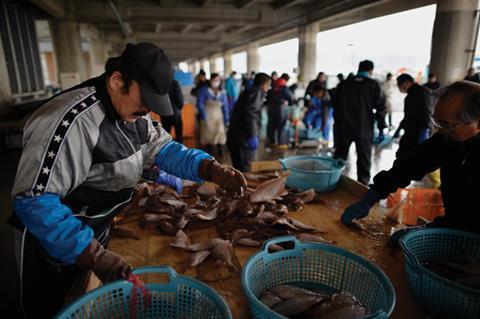
In order to track radiation from different sources and, where necessary, to reassure the public, it is necessary to measure it very precisely. ‘In the immediate aftermath of the disaster, and in the waters closest to Fukushima, you could measure radiation simply by using a Geiger counter’, says Buesseler. ‘But at more distant locations and even at the site now several years have passed, we need to use far more precise methods.’
His group has developed radiation detection methods even more precise than those used in government health laboratories. They collect 20 litre samples of sea water, filter them and pass them through ion exchangers in which either ammonium molybdophosphate or potassium–nickel hexacyanoferrate(ii) is incorporated into a modified poly-acrylonitrile binding matrix. Both 134Cs and 137Cs but no other metals bind to this matrix, which is then dried and nuclear decays measured using a high-precision gamma detector. Each isotope emits gamma photons with a specific energy when it decays, so the ratio of 134Cs to 137Cs can be measured, and this is used to determine whether caesium is from the most recent accident at Fukushima or from legacy fallout sources.
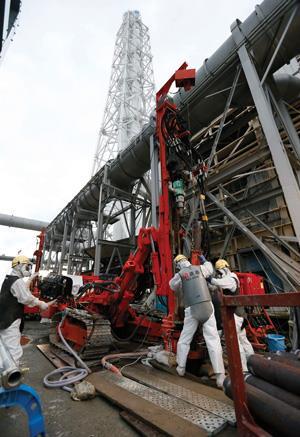
Levels of Fukushima-derived radiation in all samples except those very close to the site in the months immediately after the accident have always been lower than the background radiation from other sources, and far lower than anything that could represent a risk to human health. The situation near the reactor remains different, however. ‘Fish accumulate caesium quickly but lose it in clean water, and levels recently measured in those caught near the plant indicate that there is still some leakage,’ says Buesseler.
Similar methods for extracting caesium are now being used on a much larger scale to remove dissolved caesium from the waters close to Fukushima for remediation. The influx of large amounts of groundwater into the site of the plant is also causing problems, as this water becomes radioactive and also needs to be stored safely. The utility company Tepco and Kajima Corporation are now building what they call an ‘ice wall’ (more precisely a wall of frozen soil) around the site to keep groundwater out of the site as far as possible and reduce the need for this storage.
All scientists involved in monitoring the radiation from Fukushima or reducing its risk, whether on land, in the oceans or in the food chain, recognise that it is a task that will be measured in decades. And this represents a major challenge to the bodies that fund the work, who are used to a three to five year research grant cycle. Many of Buesseler’s measurements, which cost about $600 (£383) per sample, are now ‘crowd-funded’ by the public through a website. And the fact that serious nuclear accidents are mercifully very rare has led to a similar and perhaps unanticipated problem: a loss of expertise with the generation of scientists who retired in the years between Chernobyl and Fukushima.
Clare Sansom is a science writer based in London, UK
References
Buesseler’s crowdfunding website: http://ourradioactiveocean.org
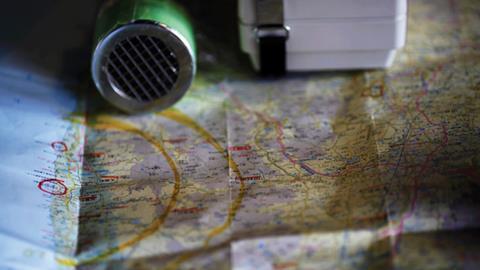
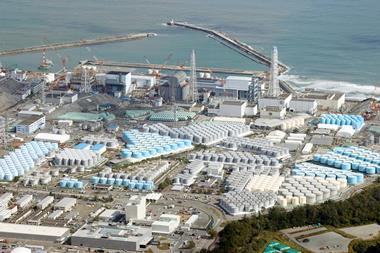
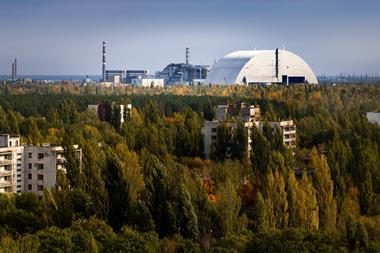
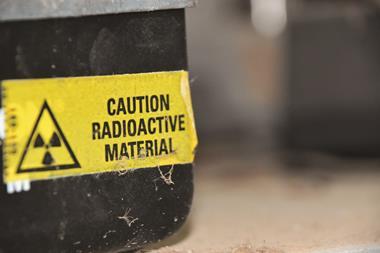
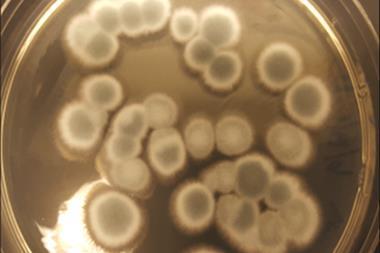








No comments yet